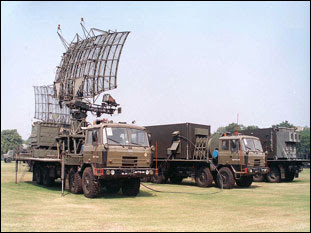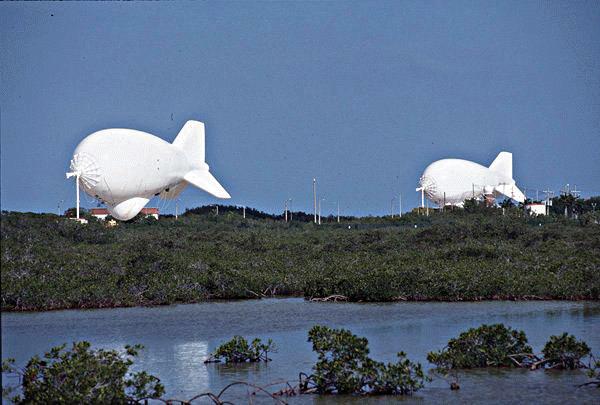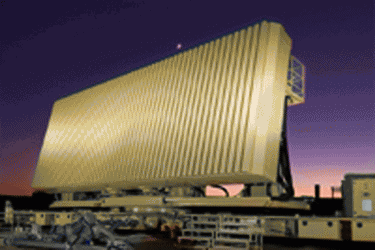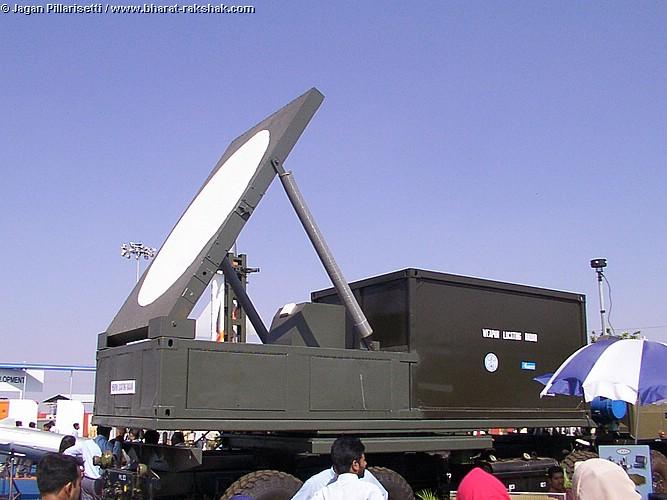How to install the app on iOS
Follow along with the video below to see how to install our site as a web app on your home screen.
Note: This feature may not be available in some browsers.
You are using an out of date browser. It may not display this or other websites correctly.
You should upgrade or use an alternative browser.
You should upgrade or use an alternative browser.
Radar power of DRDO
- Thread starter JAT BALWAN
- Start date
Major Shaitan Singh
SENIOR MEMBER

- Joined
- Dec 7, 2010
- Messages
- 3,550
- Reaction score
- 43
- Country
- Location
Indian build Radars
1. Rohini Radar

The Central Acquisition Radar (3D-CAR) is a 3D radar developed by DRDO for use with Akash SAM. The 3D CAR was developed as part of a program between DRDO and Poland's PIT to develop a family of mobile, S-Band 3D radars.
The areas of cooperation were in developing the Planar Array and general architecture. The Indian variant is the 3D CAR, a medium range surveillance radar for Akash at Group level, intended to provide high mobility and comprehensive high and low level coverage. The Polish versions, are the TRS series of S Band mobile radars such as the TRS-17 and TRS-19. The original Indian (3D CAR) and Polish (TRS 17) radars shared the basic architecture and antenna but differed in terms of purpose designed transmitter/receivers, and signal processing equipment. The TRS series for instance can track 120 targets, while the Indian radar tracks 150.
2. Rajendra Radar

The Rajendra Multi-Function Phased Array radar system, designed at the Electronics and Radar Development Establishment (LRDE), part of DRDO, is currently in production at Bharat Electronics Limited. This is named after India's First president Dr. Rajendra Prasad.
The LRDE is working on the Rajendra III radar for the Indian Army.[1] Rajendra III is a slewable phased array radar based on the T-72 chassis. As of 2007, the BLR-III vehicle on T-72 chasis was ready for a track test. The Phased array antenna is fabricated at Bharat Electronics Limited (BEL), Ghaziabad. Collimated beam pattern and s/s cure for all 16 spot frequencies has been taken.
Current orders for the Rajendra and its derivatives are at least 32 units, considering the order for 2 Squadrons of the Akash system by the Indian Air force and the indent for 28 Weapon Locating Radars by the Indian Army.
3. The Indra Radar

The Indian Doppler Radar (INDRA) series of 2D radars were developed by India's DRDO for the Army and Air Force. The INDRA-I is a is a mobile surveillance radar for low level target detection while the INDRA-II is for ground controlled interception of targets.
INDRA-I is a 2D mobile surveillance radar for low level target detection. The radar is housed in two wheeled vehicles. Some of the main features are automated Track While Scan (TWS), integrated IFF and high scan rate for high speed target detection. The radar is produced by Bharat Electronics Limited and inducted into service. The INDRA-I was a landmark project for the DRDO, as it was the first large radar system designed by the organization and produced in number for the defence forces. The Indian Air Force operates thirty INDRA-I's whereas the Indian Army also has several.
INDRA-II
It is a variant of INDRA radar for ground controlled interception of targets. The radar uses pulse compression for detection of low flying aircraft in heavy ground clutter with high range resolution and ECCM capabilities. The radar has been produced by Bharat Electronics Limited and is used by Indian Air Force and Army. Seven INDRA-IIs have been ordered by the Indian Air Force.
4.Aerostat Radar

India has recently acquired Aerostat radars. The entire system is divided in major parts. Firstly, the aerostat balloon which has been acquired from Israel and second part is the payload on board the balloon which consists, advanced programmable radar (APR), Electronic Intelligence (ELINT), Communication Intelligence (COMINT) and V/UHF radio telephony equipment and Identification Friend or Foe (IFF). It has the capability to be integrated with AWACS and ground air defence environment and funtion as a command and control centre. Depending upon the payload the theethered balloon can be raised to the height between 10000 feet to 16000 feet.
The system gives a seamless radar cover of 300 km plus at low level along with good RT range and requisite ELINT. The system could be termed as static AWACS. Off course it comes with some vulnerabilities and limitations, like weather, wind speeds, lightning & thunder, launch & recovery periods are vulnerabilities. Its virtues also make it a prime target for enemy therfore it needs to be protected by exclusive air defence weapons. But we hope that the advantages of such system would outlast the limitations
5. Sword Fish Radar

Swordfish is an Indian Long range tracking radar specifically developed to counter ballistic missile threat. It will be a part of India's ballistic missile program. First testing of this radar was in March 2009. Main aim of the test was to validate the capabilities of the indigenously developed Swordfish Long Range Tracking Radar (LRTR). "The missile to be hit will be fired from a longer distance than it was in the earlier test. DRDO tested whether the radar could track the incoming missile from that distance or not" said a member of the project.
Swordfish is an acknowledged derivative of the Israeli Green Pine long range radar, which is the critical component of that country's Arrow missile defence system. [1] However, it differs from the Israeli system as it employs Indian Transmit Receive modules, signal processing, computers and power supplies. It is also more powerful than the base Green Pine system and was developed to meet India's specific BMD needs.
6.Indian Army : Weapon Locating Radars

The BEL Weapon Locating Radar (WLR) is a mobile artillery locating Phased array radar developed by India. This counter-battery radar is designed to detect and track incoming artillery and rocket fire to determine the point of origin for Counter-battery fire.
The WLR has been jointly developed by DRDO's Bangalore based laboratory, LRDE and the Government owned Bharat Electronics Limited (BEL). The sub-systems have been fabricated by BEL based on the DRDO designs and delivered to LRDE for integration
Under development
* Weapon Locating Radar 3D passive electronically scanned array to detect multiple targets for fire correction and weapon location for Akash SAM, developed from Rajendra.
* HAL Multi-mode radar 3D advanced, lightweight multimode fire control radar for LCA Tejas.
* Airborne Warning and Control 3D Active Electronically Scanned Array
* Short Range Radar 3D tracking small fighter sized targets.
* BFSR-MR 2D medium range battlefield surveillance for the army. Probably has been replaced by long range battlefield surveillance radar.
* MFCR 3D active phased array radar, complements the Long Range Tracking Radar, for intercepting Ballistic Missiles.
* MEDIUM POWER RADAR 3D ACTIVE PHASED ARRAY RADAR, being developed for indian air force for the ranges more than 300km.
1. Rohini Radar

The Central Acquisition Radar (3D-CAR) is a 3D radar developed by DRDO for use with Akash SAM. The 3D CAR was developed as part of a program between DRDO and Poland's PIT to develop a family of mobile, S-Band 3D radars.
The areas of cooperation were in developing the Planar Array and general architecture. The Indian variant is the 3D CAR, a medium range surveillance radar for Akash at Group level, intended to provide high mobility and comprehensive high and low level coverage. The Polish versions, are the TRS series of S Band mobile radars such as the TRS-17 and TRS-19. The original Indian (3D CAR) and Polish (TRS 17) radars shared the basic architecture and antenna but differed in terms of purpose designed transmitter/receivers, and signal processing equipment. The TRS series for instance can track 120 targets, while the Indian radar tracks 150.
2. Rajendra Radar

The Rajendra Multi-Function Phased Array radar system, designed at the Electronics and Radar Development Establishment (LRDE), part of DRDO, is currently in production at Bharat Electronics Limited. This is named after India's First president Dr. Rajendra Prasad.
The LRDE is working on the Rajendra III radar for the Indian Army.[1] Rajendra III is a slewable phased array radar based on the T-72 chassis. As of 2007, the BLR-III vehicle on T-72 chasis was ready for a track test. The Phased array antenna is fabricated at Bharat Electronics Limited (BEL), Ghaziabad. Collimated beam pattern and s/s cure for all 16 spot frequencies has been taken.
Current orders for the Rajendra and its derivatives are at least 32 units, considering the order for 2 Squadrons of the Akash system by the Indian Air force and the indent for 28 Weapon Locating Radars by the Indian Army.
3. The Indra Radar

The Indian Doppler Radar (INDRA) series of 2D radars were developed by India's DRDO for the Army and Air Force. The INDRA-I is a is a mobile surveillance radar for low level target detection while the INDRA-II is for ground controlled interception of targets.
INDRA-I is a 2D mobile surveillance radar for low level target detection. The radar is housed in two wheeled vehicles. Some of the main features are automated Track While Scan (TWS), integrated IFF and high scan rate for high speed target detection. The radar is produced by Bharat Electronics Limited and inducted into service. The INDRA-I was a landmark project for the DRDO, as it was the first large radar system designed by the organization and produced in number for the defence forces. The Indian Air Force operates thirty INDRA-I's whereas the Indian Army also has several.
INDRA-II
It is a variant of INDRA radar for ground controlled interception of targets. The radar uses pulse compression for detection of low flying aircraft in heavy ground clutter with high range resolution and ECCM capabilities. The radar has been produced by Bharat Electronics Limited and is used by Indian Air Force and Army. Seven INDRA-IIs have been ordered by the Indian Air Force.
4.Aerostat Radar

India has recently acquired Aerostat radars. The entire system is divided in major parts. Firstly, the aerostat balloon which has been acquired from Israel and second part is the payload on board the balloon which consists, advanced programmable radar (APR), Electronic Intelligence (ELINT), Communication Intelligence (COMINT) and V/UHF radio telephony equipment and Identification Friend or Foe (IFF). It has the capability to be integrated with AWACS and ground air defence environment and funtion as a command and control centre. Depending upon the payload the theethered balloon can be raised to the height between 10000 feet to 16000 feet.
The system gives a seamless radar cover of 300 km plus at low level along with good RT range and requisite ELINT. The system could be termed as static AWACS. Off course it comes with some vulnerabilities and limitations, like weather, wind speeds, lightning & thunder, launch & recovery periods are vulnerabilities. Its virtues also make it a prime target for enemy therfore it needs to be protected by exclusive air defence weapons. But we hope that the advantages of such system would outlast the limitations
5. Sword Fish Radar

Swordfish is an Indian Long range tracking radar specifically developed to counter ballistic missile threat. It will be a part of India's ballistic missile program. First testing of this radar was in March 2009. Main aim of the test was to validate the capabilities of the indigenously developed Swordfish Long Range Tracking Radar (LRTR). "The missile to be hit will be fired from a longer distance than it was in the earlier test. DRDO tested whether the radar could track the incoming missile from that distance or not" said a member of the project.
Swordfish is an acknowledged derivative of the Israeli Green Pine long range radar, which is the critical component of that country's Arrow missile defence system. [1] However, it differs from the Israeli system as it employs Indian Transmit Receive modules, signal processing, computers and power supplies. It is also more powerful than the base Green Pine system and was developed to meet India's specific BMD needs.
6.Indian Army : Weapon Locating Radars

The BEL Weapon Locating Radar (WLR) is a mobile artillery locating Phased array radar developed by India. This counter-battery radar is designed to detect and track incoming artillery and rocket fire to determine the point of origin for Counter-battery fire.
The WLR has been jointly developed by DRDO's Bangalore based laboratory, LRDE and the Government owned Bharat Electronics Limited (BEL). The sub-systems have been fabricated by BEL based on the DRDO designs and delivered to LRDE for integration
Under development
* Weapon Locating Radar 3D passive electronically scanned array to detect multiple targets for fire correction and weapon location for Akash SAM, developed from Rajendra.
* HAL Multi-mode radar 3D advanced, lightweight multimode fire control radar for LCA Tejas.
* Airborne Warning and Control 3D Active Electronically Scanned Array
* Short Range Radar 3D tracking small fighter sized targets.
* BFSR-MR 2D medium range battlefield surveillance for the army. Probably has been replaced by long range battlefield surveillance radar.
* MFCR 3D active phased array radar, complements the Long Range Tracking Radar, for intercepting Ballistic Missiles.
* MEDIUM POWER RADAR 3D ACTIVE PHASED ARRAY RADAR, being developed for indian air force for the ranges more than 300km.
amardeep mishra
FULL MEMBER

- Joined
- Mar 8, 2012
- Messages
- 1,323
- Reaction score
- 26
- Country
- Location
Swordfish with range upto 1500 km has already been developed
amardeep mishra
FULL MEMBER

- Joined
- Mar 8, 2012
- Messages
- 1,323
- Reaction score
- 26
- Country
- Location
The base line version of sword fish is a derivative of green pine, though, the later upgraded variant uses completely indian subsystems, supplied by BEL, and everything is indian in that radar..The Swordfishs credit goes to Israel . They made a radar for Indian BMD
It is better in performance to the ELTA'S green pine
The Swordfishs credit goes to Israel . They made a radar for Indian BMD
Yes and NO.Yes for the 1st part as the Sword Fish MkI is based on Israelly Green Pine mk1.
No for the 2nd part.The Sword Fish is built with completely Indian components-the t/r modules,antena array unit,back processor,source code,power management system-everything is Indian developed and produced.Beside,the Sword Fish MkI has tracking range of 600 km against fighters as compared to base line Green Pine.
So,you may say Sword Fish is 'India's J 11A' (though legal as it was done only after the Israellis agreed to).
karan21
SENIOR MEMBER

- Joined
- Mar 6, 2012
- Messages
- 3,062
- Reaction score
- -9
The Swordfishs credit goes to Israel . They made a radar for Indian BMD
u can compare the swordfish radar to chinas j 11 program. buy the product -> master the tech -> make ur own components and fit them in-> phuck yeah its ourss

Kinetic
BANNED

- Joined
- Feb 12, 2010
- Messages
- 11,200
- Reaction score
- -33
The Swordfishs credit goes to Israel . They made a radar for Indian BMD
Most of the technologies for SF is Indian including the TR modules.
karan21
SENIOR MEMBER

- Joined
- Mar 6, 2012
- Messages
- 3,062
- Reaction score
- -9
Why many people using their after burners?
Israelis and you assembled radars at your place . That will not make it your own radar .
everything in the radar is indian and its much more powerfull than sf. better than ur indegeneous j 11 program atleast we copied their product and put in our sensors with their permission.
u didnt copy man , you paid money , israelis paid for youeverything in the radar is indian and its much more powerfull than sf. better than ur indegeneous j 11 program atleast we copied their product and put in our sensors with their permission.
Kinetic
BANNED

- Joined
- Feb 12, 2010
- Messages
- 11,200
- Reaction score
- -33
Why many people using their after burners?
Israelis and you assembled radars at your place . That will not make it your own radar .
People with after burners? Is it the first new technology invented by you?
 How many you got on your back?
How many you got on your back? BTW its difficult to digest every times India develop something. This way you will have loose motion soon as lots of systems are ready for induction in next few years. lol
i mean burning a** . India developed? what a jokePeople with after burners? Is it the first new technology invented by you?How many you got on your back?
BTW its difficult to digest every times India develop something. This way you will have loose motion soon as lots of systems are ready for induction in next few years. lol
 i wonder how many time you were when China is making the things indigenous .
i wonder how many time you were when China is making the things indigenous .karan21
SENIOR MEMBER

- Joined
- Mar 6, 2012
- Messages
- 3,062
- Reaction score
- -9
u didnt copy man , you paid money , israelis paid for you
first u said you paid money and then u said isrealis paid for u. relax its none of ur buisness anyways. its our radar with completely our electronics and sensors. and i have nothing more to tell u abt this. seems like u already have more secret info abt thsi radar. keep burning
Similar threads
- Replies
- 9
- Views
- 1K
- Article
- Replies
- 0
- Views
- 592
- Replies
- 0
- Views
- 711
- Replies
- 22
- Views
- 3K



